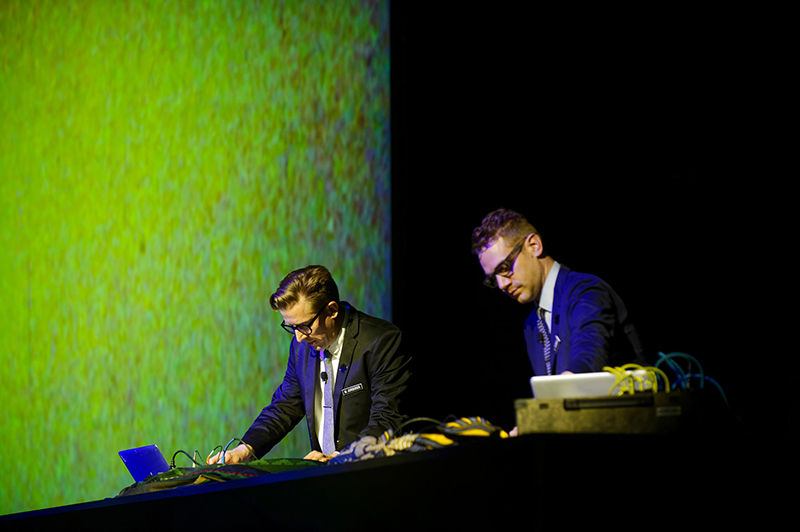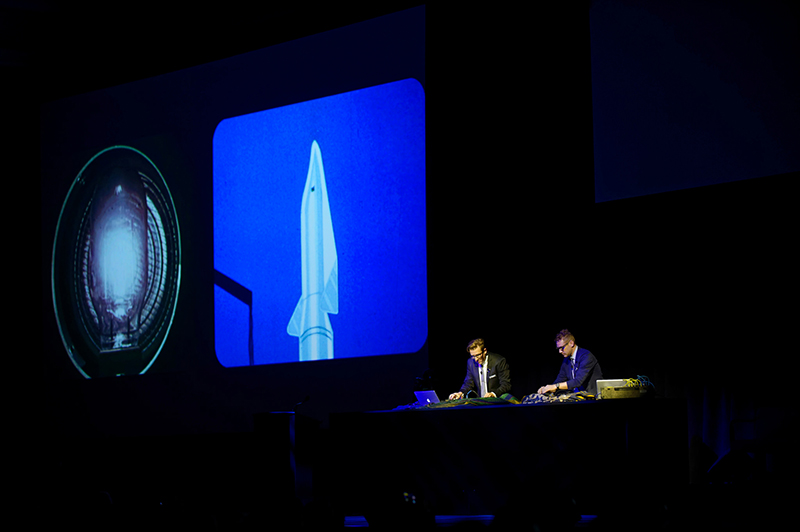Mid-afternoon on the second day of the 2016 AIGA Design Conference in Las Vegas, musicians James Merle Thomas and Mikael Jorgensen of the band Quindar took the main stage. With little introduction, the duo took the 2000-person audience on a 20-minute sonic and visual journey. Images and sounds from the NASA archives washed over the room, remixed into music, and transformed with accompanying video.
The work of Quindar fundamentally reflects core aspects of the way many designers work: reshaping, remixing, and re-contextualizing elements from the world around us, bringing new meaning to content through process. Design, music, and art have long shared a history of using these processes to achieve transformation.

Quindar performance at AIGA National Convention, 2016
The band Quindar takes its name from the sounds that begin and end every historic NASA audio recording. Explained by James Merle Thomas, “Simply put, a quindar tone is the sound of a communication system working…Quindar [the band] is a statement about communication, like a handshake, a code, or a checksum. From the start we asked: What happens when we intervene into these ‘fixed’ sounds as a kind of industrial standard, and use them as a compositional element?”
Design is also accustomed to remixing.
The work of Sister Corita Kent, one of AIGA’s 2016 medalists, demonstrates a process that was revolutionary in that, like Quindar, it gave new value to the material used in her work. Kent’s source materials included grocery store labels for Del Monte canned corn, Wonder Bread, and Bell Potato Chips. In her process she distilled them to their core graphic elements, distorted as she applied them to the page, silk screened in intense day-glow colors. Kent transformed the graphic roots of everyday products into powerful works of art. What might have been barely noticeable on grocery store shelves in the haze of our daily lives was turned into impactful works on spirituality, humanity, God, politics, and soul. The mundane became remarkable through her process of visual remixing.
Sister Corita Kent co-opted visuals and advertising slogans from brands that blended into our everyday lives. With the emergence of television in living rooms across the country and, affordable portable radios, Kent’s early work was developed at a time in our history when society’s relationship with media started becoming much more immediate and complex. With this acceleration in media consumption—that has only accelerated more rapidly every year since, we can become desensitized by all of the noise out there; “hearing without listening” as Simon and Garfunkel sang in the Sound Of Silence. In this same way, Quindar abates this sense of apathy by taking mundane sounds we "hear" but may not pay attention to, and remixing them with images to make them meaningful and something actually worth listening to.
Composer and sound artist Steve Reich provided another example of how, through reappropriating an original source, art can allow people to see “normal” in a new way. Fifty years before the advent of the Black Lives Matter movement, Reich created Come Out, what writer Andy Beta called “one of the most visceral pieces of music of the 20th century,” in the article “Blood and Echoes: The Story of Come Out, Steve Reich’s Civil Rights Era Masterpiece.” Come Out, a Civil Rights Era masterpiece, was a tape loop experiment that put forth the voice of Daniel Hamm, one of six black teenagers later known as “the Harlem Six” that were accused of murder in association with the famous “Little Fruit Stand Riot,” which occurred in 1964. (Five were ultimately found not guilty.)
As described in “Blood and Echoes,” Hamm was one of two black teenagers brutalized while in police custody in order to extract a confession for a crime they did not commit. The 20 words recounting Hamm’s experience foreshadowed the forceful hashtags of today like #ICantBreathe, which aim to create a unified experience from a specific event. Reich remixed Hamm’s account of the events as a perpetual cannon, looping over and over, until the echo of the repeating words became a seamless reverberation swathed in reverb. As Hamm’s looping voice tracks out of synch, it becomes a transfixing spiritual and mechanical meditation on the recounting of his experience.
Even after Hamm’s story largely vanished from popular vernacular, Come Out continues to resonate as a work of art and as a cultural signpost influencing the likes of Janelle Monáe today. It is recontextualized and remixed by Reich in a way that makes it potent, compelling, and lasting.
In July of 1969, five years after the events of Hamm and the 32nd precinct, and with half a billion people watching, Apollo 11 landed on the moon. Broadcast on television live, the bravery and risk of the mission was visceral. CBS covered the Apollo 11 landing for thirty-two continuous hours and had set up special screens in Central Park so that people could watch in a crowd. The live television experience of the moon landing became a genuine experience of global intimacy. David Meerman Scott and Richard Jurek write further in their book, Marketing the Moon (MIT Press), that “a government program with a limited marketing budget, whose standard operating procedure had been secrecy, turned its greatest achievement into a worldwide communal experience of brand journalism,” and asserted that American astronauts not only became the heroic and patriotic faces of the program and the products they brought with them on their travels (like Hasselblad cameras, Sony tape recorders, and Tang), but were also among television’s first celebrity heroes.
In less than three years, the Apollo program became a victim of its own success. Humans traveling to the moon, an accomplishment that was at first acknowledged as a monumental turning point in human history, was reduced to something commonplace by the same frequency of repetition and media inundation. The impossible had become expected: Just another trip to the moon, just another moon walk. Successive Apollo missions in the works of a 1970 newspaper editorial became “virtual reruns”. The space program had become too ordinary for television. An example of the exceptional becoming normal when simply repeated enough.

Quindar performance at AIGA National Convention, 2016
However, as we see and hear in the examples provided by Kent, Reich, and Quindar, when processed creatively and artistically, with intent to spotlight key messages, the power of the remix can transform what is mundane to the exceptional.
In discussing transforming vintage source material to contemporary art, James Merle Thomas of Quindar explains that, “I’m not interested in uncritically rehearsing that past, but rather, disrupting the ways that we’ve naturalized its narrative force. I see Quindar’s music as not merely an ornament layered on top of NASA’s history—which inherently has a kind of tightly scripted ‘heroic’ narrative that often glosses its relationship to questions of ideology and technology—but instead, as critically derived from a kind of ‘period sound,’ one that encompasses everything from NASA, to Watergate, to Grateful Dead concert tapes. So how does one carry that idea over into the contemporary? Given that quindar tones are an obsolete technology, a question I keep coming back to is: What are the quindar tones of our current moment? What are the sounds (or codes, or forms) that we are now naturalizing, that we uncritically adopt and cherish?”
In uncovering the current tones of our moment, Quindar transforms the source material used for their music—the quotidian workaday training and transmissions between mission control and astronauts in space—into lush transformative music. Mikael Jorgensen explains, “Rather than telling a traditional linear story, it’s interesting to isolate constituent pieces and then reassemble them in a way that feels compelling and new.”
As Sister Corita Kent said, “It takes practice for us to recover this ability to see, or before that, the gift of wanting to see. For so many years we have been learning to judge and dismiss—I know what that thing is, I’ve seen it a hundred times, and we’ve lost the complex realities and details that surround us.”
Through this process—be it x-acto and rubber cement, a modular synthesizer, or photoshop— designers and musicians alike have the power to reshape meaning in a way that gives the viewer and listener the opportunity to rediscover what we think we know, and to experience the world anew.
